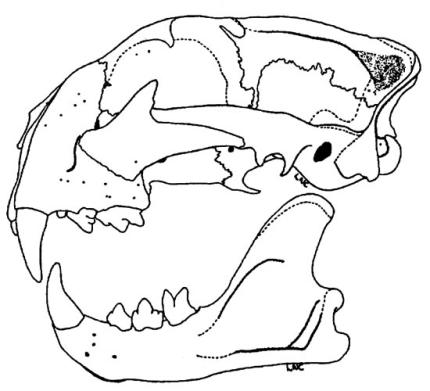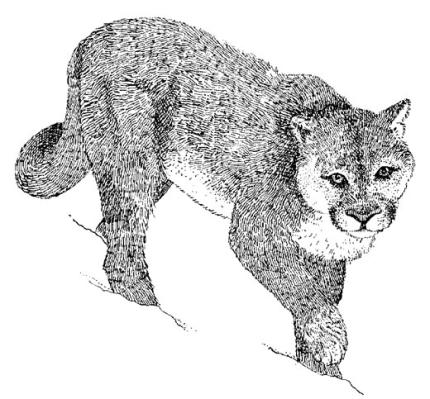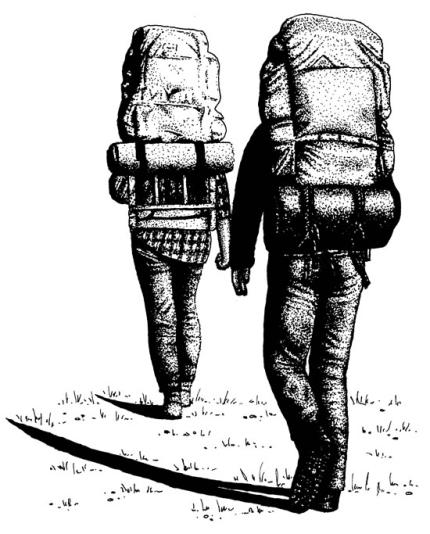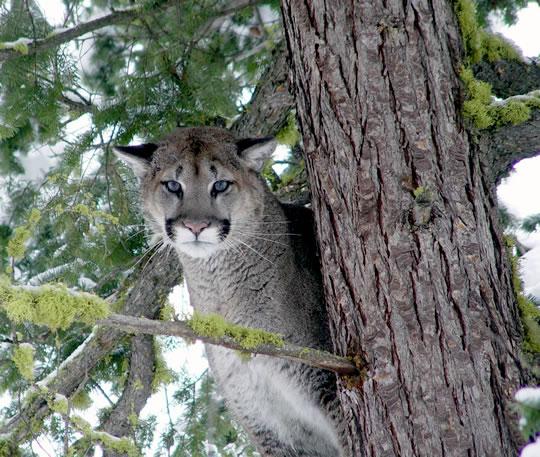Sleek and graceful, cougars (Puma concolor ) are solitary and secretive animals rarely seen in the wild. Also known as mountain lions or pumas, cougars are known for their strength, agility, and awesome ability to jump.
Description and Range
Physical description
Cougars are the largest members of the cat family in Washington. Adult males average approximately 140 pounds but in rare cases may weigh 180 pounds and measure 7-8 feet long from nose to tip of tail. Adult males stand about 30 inches tall at the shoulder. Adult female cougars rarely exceed 110 pounds. Cougars vary in color from reddish-brown to tawny (deerlike) to gray, with a black tip on their long tail. Cougar kittens are spotted until they are 4-5 months old, after that, barring patterns may remain up to 14 months of age. For additional information, see this cougar brochure (PDF).
Geographic range
Cougars occur throughout Washington where suitable cover and prey are found. Cougars use steep canyons, rock outcroppings and boulders, or vegetation -- such as dense brush and forests -- to remain hidden while hunting. Adult male cougars roam widely, covering a home range of 50 to 150 square miles, depending on the age of the cougar, the time of year, type of terrain, and availability of prey. Adult male cougars’ home ranges will often overlap those of three or four females. Female home ranges are about half that of males and there in considerable overlap in female home ranges. Often female progeny will establish a territory adjacent to mother, while virtually all males disperse considerable distances from the natal area.
WDFW does not regularly monitor or count individual numbers of cougars in Washington. WDFW can estimate cougar populations in Washington based on population density research that is extrapolated to the amount of suitable cougar habitat in the state. WDFW currently estimates that approximately 2,400 independent-aged cougars live in Washington. An “independent aged” cougar is one that is old enough to be living on its own, including sub-adult and adult animals.
Cougar's range often overlaps with other predators like wolves and bobcats. WDFW is currently conducting the Washington Predator-Prey Project that looks at the impact of wolf recovery on other species like cougars, deer, and elk.
Regulations
Licenses and permits
A valid big game license, which includes cougar as a species option, is required.
Rules and seasons
The current cougar hunting season runs from September 1, 2024 – March 31, 2025.
Cougar hunters may hunt cougar through March 31, except in Game Management Units (GMUs) where the harvest cap has been reached and the WDFW director has closed the Population Management Unit (PMU) for cougar hunting for the season. All human-caused cougar mortality between April 1, 2024 and March 31, 2025 shall be counted toward the harvest cap.
It is each cougar hunter's responsibility to verify if the cougar hunting season is open or closed in hunt areas with a harvest cap. Cougar hunters can verify if the season is open or closed by visiting the Cougar hunting area openings and closures webpage or calling the toll-free Cougar Hotline at 1-866-364-4868 (press 2 after greeting).
Cougar hunters must adhere to the following requirements;
- All hunters must report their harvest within 72 hours via the toll-free Cougar Hotline (1-866-364-4868, press 3 after greeting).
- Cougars must be sealed at any WDFW office within five days of harvest. Cougar must be unfrozen with proof of sex attached.
- Regardless of harvest success, please report your early & late season hunt activity separately via the WILD licensing system. More information on harvest reporting is available here: Reporting your harvest webpage
The statewide bag limit is one cougar per license year. A transport tag is included with a big game hunting license that has cougar as a species option.
Hunters can use any legal weapon for hunting cougar. The use of dogs for recreational cougar hunting is prohibited statewide.
It is unlawful to kill or possess spotted cougar kittens (usually <80 lbs.) or adult cougars accompanied by spotted kittens. Since cougars are solitary, observing multiple tracks likely means a female with offspring. Kitten tracks may appear similar in size to an adult, so please be sure to abide by the law (WAC 220-415-100).
See the Cougar General Seasons section of the Big Game Hunting pamphlet for more information.
Living with wildlife
Food and feeding habits

Cougars are most active from dusk to dawn, but it is not unusual for cougars to hunt anytime during the day. Adult cougars typically prey on deer, elk, moose, mountain goats, and wild sheep, with deer being the preferred and most common prey. Other prey species, especially for younger cougars, include raccoons, coyotes, rabbits, hares, small rodents, and occasionally pets and livestock (e.g. goats, sheep, and chickens). A large male cougar living in the Cascade Mountains kills a deer or elk every 9 to 12 days, eating up to 20 pounds at a time and burying the rest for later. Except for females with young, cougars are lone hunters that wander between places frequented by their prey, covering as much as 15 miles in a single night. Cougars rely on short bursts of speed to ambush their prey. A cougar may stalk an animal for an hour or more.
Feeding areas (caches)
Cougars usually carry or drag their kills to a secluded area under cover to feed, and drag marks are frequently found at fresh kill sites. After killing a large animal and having eaten its fill, a cougar often will cover the remains with debris such as snow, grass, leaves, sticks, or soil. Even where little debris is available, bits of soil, rock, grass or sticks may be used to cover the carcass. The cougar may remain in the immediate vicinity of its kill, guarding it against scavengers and eating it over a period of six to eight days. (Meat becomes rotten quickly in the summer and male cougars have to patrol their territory. Often these males will make a kill, feed until full, leave to patrol the area, and return to feed on the carcass days later.)
Do not approach or linger around a recently killed or partially covered deer or elk.
Tracks
Cougar tend to leave “soft” tracks, meaning the animals make very little impact on the ground, and their tracks may be virtually invisible on packed earth or crusted snow. In addition, to preserve their sharpness for gripping prey, these animals keep their claws retracted most of the time, and so claw marks are rarely visible in their tracks.
Because cougars carry their heavy tail in a wide U shape at a normal walk, in snow, the lowermost portion may leave drag marks between each print.
Droppings
Cougars generally cover their droppings with loose soil. When visible, their droppings typically resemble those of most species in the dog and cat families. However, cougars have well developed premolars that can slice through bone and hide. Therefore, their droppings often show chunks and fragments of chewed bone and considerable hair from the hide. Members of the dog family gnaw on bones but usually don’t chew them up into cut fragments.

Cougar droppings are generally cylindrical in shape, segmented, and blunt at one or both ends. An average dropping measures 4 to 6 inches long by 1 to 1½ inches in diameter. The size of the dropping may indicate the size of the cougar.
Daybed sites
A cougar’s daybed is used for rest, protection from the weather, and to raise young. Cougars don’t use dens like bears do. They may settle down for up to six weeks while the kittens are immobile, but afterward are almost always on the move, making daybeds as they go. In rough terrain, daybeds are usually in a cave or a shallow nook on a cliff face or rock outcrop. In less mountainous areas, day beds are located in forested areas, thickets, or under large roots or fallen trees. Daybeds are frequently near kill sites. No day beds preparation takes place.
Scratching posts
Like house cats scratching furniture, cougars mark their territory boundaries by leaving claw marks on trees, stumps, and occasionally fence posts. Claw marks left by an adult cougar will be 4 to 8 feet above the ground and consist of long, deep, parallel scratches running almost vertically down the trunk. These gashes rarely take off much bark; tree-clawing that removes much bark is probably the work of a bear. (Bobcat claw marks are normally 2 to 3 feet above the ground; domestic cat scratching occurs at a height of about 1½ to 2 feet).
Calls
Cougars hiss, purr, mew, growl, yowl, chirp, and cry. The most sensational sounds they make are the eerie wailings and moans heard at night during mating season, especially when competing males have intentions toward the same receptive female. Such wails have been likened to a child crying, a woman’s scream, and the screeching of someone in terrible pain.
Preventing conflict
The cougar’s ability to travel long distances occasionally brings these cats into seemingly inappropriate areas, even places densely settled by humans. Such appearances are almost always brief, with the animal moving along quickly in its search of a suitable permanent home. However, when humans occupy areas in or near wildlife habitat, and people choose to keep livestock animals such as goats, sheep, and chicken cougar sightings and attacks on livestock and pets may occur.
Cougar attacks on humans are rare. In Washington state, there have been two fatal cougar attacks and approximately 20 other recorded encounters that resulted in human injury in the last 100 years.
If you are living in cougar country, prevent a conflict with them by using the following management strategies around your property, and, if possible, encourage your neighbors to do the same.
Modify the habitat around your home. Light all walkways after dark and avoid landscaping with plants that deer prefer to eat. Where a deer goes, a cougar may follow. Shrubs and trees around kids’ play areas should be pruned up several feet to prevent cougars from hiding behind them.
Although costly and not 100 percent effective, a chain-link or heavy woven wire fence that is 10 feet high with 3-foot extensions installed at a 65-degree angle on each post may keep cougars out of an enclosed area. To increase effectiveness, string barbed wire or four electric wires between the extensions, alternating positive and negative wires.
Don’t feed wildlife and feral cats (domestic cats gone wild). This includes deer, raccoons, and other small mammals. Remember predators follow prey.
Close off open spaces under structures. Areas beneath porches and decks can provide shelter for prey animals.
Feed dogs and cats indoors. If you must feed outside, do so in the morning or midday, and pick up food and water bowls, as well as leftovers and spilled food, well before dark. Pet food and water attract small mammals that, in turn, attract cougars.
Keep dogs and cats indoors, especially from dusk to dawn. Left outside at night, small dogs and cats may become prey for cougars.
Use garbage cans with tight-fitting lids. Garbage attracts small mammals that, in turn, attract cougars.
Livestock and small animals, such as goats, sheep, and chickens, are attractants to cougars. Outdoor livestock should be kept in secure pens and away from forest boundaries. For a larger property, consider using a guard animal. There are specialty breeds of dogs that can defend livestock. As with any guard animal, pros and cons exist. Purchase a guard animal from a reputable breeder who knows the animal he or she sells. Some breeders offer various guarantees on their guard animals, including a replacement if an animal fails to perform as expected.
Download our Discover Washington's cougars brochure (PDF).
Download our Coexisting with cougars in Washington: a guide for small livestock owners. (PDF)
Coexistencia con los pumas en Washington: guía para pequeños granjeros (PDF)
与 Washington 的美洲狮 和谐共存: 告小型牲畜主人知 (PDF)
Cùng tồn tại với báo sư tử ở Washington Hướng dẫn dành cho các chủ chăn nuôi nhỏ (PDF)
Encountering a cougar
Relatively few people will ever catch a glimpse of a cougar much less confront one. If you come face to face with a cougar, your actions can either help or hinder a quick retreat by the animal.
Here are some things to remember:
- Stop, pick up small children immediately, and don’t run. Running and rapid movements may trigger an attack. Remember, at close range, a cougar’s instinct is to chase.
- Face the cougar. Talk to it firmly while slowly backing away. Always leave the animal an escape route.
- Try to appear larger than the cougar. Get above it (e.g., step up onto a rock or stump). If wearing a jacket, hold it open to further increase your apparent size. If you are in a group, stand shoulder-to-shoulder to appear intimidating.
- Do not take your eyes off the cougar or turn your back. Do not crouch down or try to hide.
- Never approach the cougar, especially if it is near a kill or with kittens, and never offer it food.
- If the cougar does not flee, be more assertive. If it shows signs of aggression (crouches with ears back, teeth bared, hissing, tail twitching, and hind feet pumping in preparation to jump), shout, wave your arms and throw anything you have available (water bottle, book, backpack). The idea is to convince the cougar that you are not prey, but a potential danger.
- If the cougar attacks, fight back. Be aggressive and try to stay on your feet. Cougars have been driven away by people who have fought back using anything within reach, including sticks, rocks, shovels, backpacks, and clothing—even bare hands. If you are aggressive enough, a cougar will flee, realizing it has made a mistake. Pepper spray in the cougar’s face is also effective in the unlikely event of a close encounter with a cougar.
Professional assistance
Wildlife offices throughout Washington respond to cougar sightings when there is a threat to public safety or property. Cougars involved in human conflict may be live-trapped by trained fish and wildlife personnel and moved to more remote areas, or removed. However, both are expensive, time consuming, and do not address the root cause of the problem. It is common that husbandry practices need to be addressed to avoid a repeated conflict.
Contact your local wildlife office for additional information, and in the case of an immediate emergency, call 911 or any local law enforcement office, such as the state patrol.
Cougars and kids
- Talk to children and teach them what to do if they encounter a cougar.
- Encourage children to play outdoors in groups, and supervise children playing outdoors.
- Consider getting a dog for your children as an early-warning system. A dog can see, smell, and hear a cougar sooner than we can. Although dogs offer little value as a deterrent to cougars, they may distract a cougar from attacking a human.
- Consider erecting a fence around play areas.
- Keep a radio playing when children are outside, as noise usually deters cougars.
- Make sure children are home before dusk and stay inside until after dawn.
- If there have been cougar sightings, escort children to the bus stop in the early morning. Clear shrubs away around the bus stop, making an area with a 30-foot radius. Have a light installed as a general safety precaution.
Precautions for hikers and campers

While recreating in a cougar’s territory, you can avoid close encounters by taking the following precautions:
- Hike in groups and make enough noise to prevent surprising a cougar.
- Avoid hiking after dark.
- Keep small children close to the group, preferably in plain sight ahead of you.
- Do not approach dead animals, especially recently killed or partially covered deer and elk.
- Be aware of your surroundings, particularly when hiking in dense cover or when sitting, crouching, or lying down. Look for tracks, scratch posts, and partially covered droppings.
- Keep a clean camp. Reduce odors that might attract mammals such as raccoons, which in turn could attract cougars. Store meat, other foods, pet food, and garbage in double plastic bags.
Public health concerns
Cougars rarely carry any communicable diseases that are regarded as threats to humans in Washington.
Feline distemper (Feline panleukopenia) antibodies have been documented in Washington cougar populations, but the degree that the Feline panleukopenia virus causes cougar mortality, or is transferred to domestic cats, is unknown.
Legal status
Because the legal status, hunting restrictions, and other information relating to cougars change, contact your local wildlife office for updates.
Cougars are classified as game animals and an open season and a hunting license are required to hunt them (WAC 220-400-020). A property owner or the owner’s immediate family, employee, or tenant may kill a cougar on that property if it is damaging domestic animals (RCW 77.36.030). No permit is required.
The killing of a cougar in self-defense, or defense of another, should be reasonable and justified. A person taking such action must have reasonable belief that the cougar poses a threat of serious physical harm, that this harm is imminent, and the action is the only reasonable available means to prevent that harm.
The body of any cougar, whether taken under the direct authority of RCW 77.36.030, or for the protection of a person, remains the property of the state and must be turned over to the Department of Fish and Wildlife immediately.
